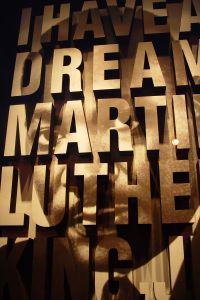
On August 28, 1963, Dr. Martin Luther King, Jr. lead the March on Washington and delivered his famous “I Have A Dream” speech. He spoke of a world where all people, regardless of race, could join hands and live together in harmony. As we reflect on the 50th anniversary of the March on Washington, the question is: has Dr. King’s dream truly been realized?
I say, no.
Over the last 50 years, we have come a long way as far as bridging the gap among races, but we’re not living in the utopia Dr. King described. People are so adamant about racial equality, but we have yet to discuss and repair an issue that keeps us from living in complete peace and harmony within our own racial communities: colorism.
Colorism is a form of prejudice based on skin color in which members of a racial or ethnic community are discriminated against based on the social meaning(s) attached to their skin tone. This is not something that affects the Black community alone; the Asian and Hispanic communities also face prejudice from their peers if they are “too dark.”
This summer, Oprah’s documentary “Dark Girls” made its debut and caused its viewing audience to spark conversations about how darker individuals are at a social and economical disadvantage.
For instance, studies conducted in early 2001 and 2006 show that criminals with darker skin receive heavier prison sentences than lighter skinned criminals who have committed the same crime and have similar criminal records.
Not only that, but when it comes to mate selection in the Black community, a 2012 study titled “Shedding ‘Light’ On Marriage” showed that those with lighter skin and Euro-centric features are preferred over those with darker skin and Afro-centric features.
Again, colorism isn’t something that affects the Black community alone. Consider the fact that members of the Hispanic community classify themselves as either Black or White Hispanic. That’s division in itself!
Also, it has been reported that Latinos with lighter skin earn approximately $5,000 more than Latinos with darker skin, and those with darker skin usually receive longer prison sentences as well.
As for the Asian community, fair skin is extremely admired. For instance, women collectively, spend millions on whitening cosmetic products to become as light as possible.
There have been reports of some Whites who face colorism, too. Many have been teased because they are “too pale” and are considered as unattractive compared to their tan counterparts. Some Whites with pale skin have reflected on being envious of their classmates who could tan easily or naturally had a semi-warm complexion.
Being referred to as “albino” and ostracized by classmates cause a great blow to the self-esteem of individuals considered as “pale.” Some have admitted to sunbathing for extended periods of time, at the risk of developing skin cancer, just to fit in.
It has been 50 years since Dr. King delivered his “I Have A Dream” speech. Dr. King wanted us to live in a world where we are “not judged by the color of [our] skin but by the content of [our] character.”
If you ask me, his dream doesn’t speak out against racism alone. He wanted us to appreciate the skin tones of everyone including those inside of our respective racial communities.
With Black people still claiming “team light skinned” or “team dark skinned” on social media, 40 percent of Asian women admitting to bleaching their skin for a lighter complexion, and White teenagers being bullied into tanning beds, Dr. King’s dream is far from becoming a reality.
